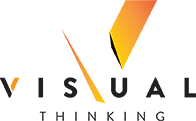
VISUALITY & THE TWO PRIMES
The visual world and I…. The visual world and you. Such a perfect relationship. We see and we understand. And when we see and understand on the job, work happens without struggle. It flows. And like the pull systems it supports, a visual workplace creates pull between itself and us, the user. We pull information to us—when and as we need it—because it was we who determined that that information was vital to us; and we who turned that needed information into visual devices. We gave our work area the voice with which it now speaks to us. Pretty amazing, huh!
In this final article in our eight-part series on The Invisible Enemy, we tie up loose ends by examining a set of three strong anchor points. The first are what I call The Two Primes: 1) To tell merely by looking and 2) To tell the difference merely by looking. These are the two core principles that underpin of all visuality—no matter the work setting and even when we are where no work happens (at movies or a boxing match).
I touched upon these two principles in last week’s issue of The Visual Thinker when I discussed the indexed final assembly line that I had visited over 30 years ago on a study mission to a Toyota site, just outside Tokyo.
![]() Prime 1 allows us to participate in the world around us and understand how that world should—and should not—work because of the visual information sharing that is designed in as part of that world. As you recall, a light pink powder residue on a lug nut told an operator that he had already applied his impact wrench to it.
Prime 1 allows us to participate in the world around us and understand how that world should—and should not—work because of the visual information sharing that is designed in as part of that world. As you recall, a light pink powder residue on a lug nut told an operator that he had already applied his impact wrench to it.
The operator could tell merely by looking. In fact, he devised the powder as an information-sharing device for the very purpose of enabling him to TELL—strictly on his own, without a single question to anyone else—that he had torqued the lug nut. No hoping. No guessing. Simply knowing—with certainty.
![]() Prime 2 provides more information—and more meaning. That same operator can tell—all by himself and instantly—which lug nut he had overlooked if the line does not index. The workplace speaks—as a result he (and all the operators) like him, can work independently, make his own decisions, respond immediately. He is self-sufficient.
Prime 2 provides more information—and more meaning. That same operator can tell—all by himself and instantly—which lug nut he had overlooked if the line does not index. The workplace speaks—as a result he (and all the operators) like him, can work independently, make his own decisions, respond immediately. He is self-sufficient.
The opportunity is enormous, with the promise of a 15% to 30% increase in work productivity as a common result. This impact multiplies when we realize that 50% of human brain function is dedicated to finding and interpreting visual data. That means we are sense-based beings—and our sense of sight does not just dominate: It rules. We have designed visuality into our world so that we can navigate in it and through it. It is also part and parcel of how we contribute to its betterment. Let the workplace speak.Yes, it is difficult to overestimate the massive negative impact triggered by the info deficits. But we have two aces-in-the-hole to help us. First, we now know how to name and track the enemy’s footprint—motion/moving without working. And we can wipe out both that footprint and the enemy through solutions that are visual. We can become visual thinkers.

 Here another example of the Two Primes. The plain black-on-white cisplatin address on the left (A) is useful—indeed, how would we find this important chemotherapy medicine without it? But the address on the right (B)—with its first three letters enlarged and backed in green—is doubly valuable because we not only can reliably locate the medicine, we can also tell the difference merely-by-looking between it and, for example, transplatin, another chemo drug with its own set of counter-indications. Think of the motion of an informational mix up here!
Here another example of the Two Primes. The plain black-on-white cisplatin address on the left (A) is useful—indeed, how would we find this important chemotherapy medicine without it? But the address on the right (B)—with its first three letters enlarged and backed in green—is doubly valuable because we not only can reliably locate the medicine, we can also tell the difference merely-by-looking between it and, for example, transplatin, another chemo drug with its own set of counter-indications. Think of the motion of an informational mix up here!
Yes, it is difficult to overestimate the massive negative impact triggered by the info deficits. But we have two aces-in-the-hole to help us. First, we now know how to name and track the enemy’s footprint—motion/moving without working. And we can wipe out both that footprint and the enemy through solutions that are visual. We can become visual thinkers.
The opportunity is enormous, with the promise of a 15% to 30% increase in work productivity as a common result. This impact multiplies when we realize that 50% of human brain function is dedicated to finding and interpreting visual data. That means we are sense-based beings—and our sense of sight does not just dominate: It rules. We have designed visuality into our world so that we can navigate in it and through it. It is also part and parcel of how we contribute to its betterment. Let the workplace speak.



